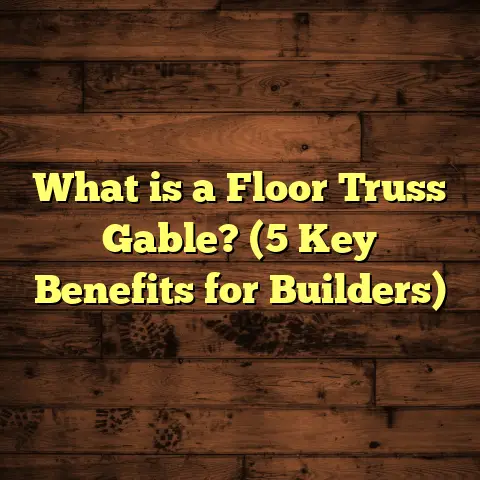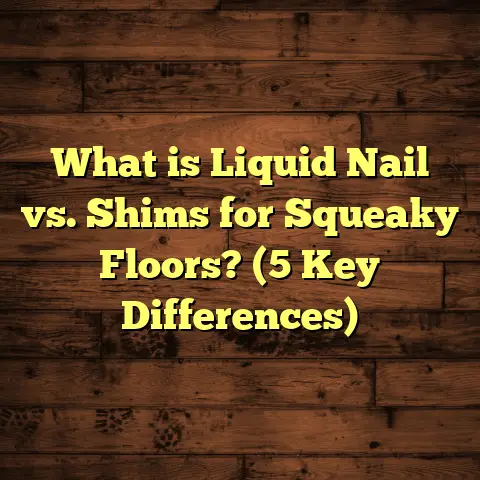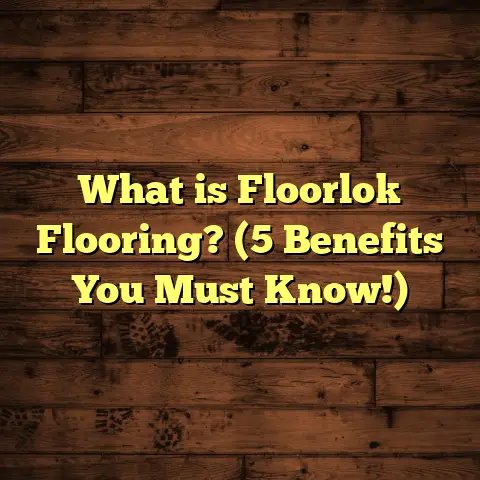What is Better for Flooring: Vinyl or Laminate? (5 Key Comparisons)
Vinyl vs Laminate Flooring: What’s the Real Difference?
Lately, I’ve noticed more and more people asking me about vinyl and laminate flooring. It seems like everyone wants floors that look great but don’t break the bank or require endless maintenance. I get it — choosing the right flooring can feel overwhelming with so many options out there. Over the years, I’ve worked with both vinyl and laminate in hundreds of homes, so I thought I’d share what I’ve learned. Let’s explore five important comparisons that can help you decide which one is better suited for your space.
What Exactly Are Vinyl and Laminate Flooring?
Before we jump into comparisons, let me clarify what these two types of flooring actually are.
Vinyl flooring is made from synthetic materials, primarily polyvinyl chloride (PVC). It’s designed to be waterproof, durable, and versatile. Vinyl comes in sheets, tiles, or planks that mimic the look of wood, stone, or tile.
Laminate flooring, on the other hand, is a multi-layered product with a fiberboard core topped by a photographic layer that resembles wood or stone, sealed with a clear protective coating. It’s not made of actual wood but aims to give you a similar look and feel at a lower cost.
I’ve installed both types countless times, and while they might look similar at first glance, their construction and performance vary quite a bit.
1. Durability and Water Resistance: How Tough Are They?
One of the first questions I ask homeowners is: “How much foot traffic and moisture will your floors face?” This really shapes which material will fit best.
Vinyl Flooring: Waterproof Warrior
Vinyl flooring is practically waterproof. Its plastic composition means water just sits on the surface without soaking in. I’ve had customers install vinyl in bathrooms, kitchens, even basements — places where moisture is an everyday challenge. According to recent industry data from the Resilient Floor Covering Institute (RFCI), vinyl planks can withstand standing water for hours without damage.
In one project, I installed luxury vinyl planks (LVP) in a family’s basement that often experienced flooding during heavy rains. Unlike their previous hardwood floors that warped beyond repair, the vinyl held up perfectly after several flood incidents. This real-world example showed me how vinyl’s waterproof nature can save homeowners money and stress in moisture-prone areas.
Vinyl also resists stains and scratches better than many expect. The top wear layer, often made of urethane or ceramic-enhanced coatings, protects it from everyday abuse such as pet claws or heavy furniture.
Laminate Flooring: Sensitive But Improving
Laminate flooring is more sensitive to moisture. While some newer laminates offer water-resistant or even waterproof versions, traditional laminate can swell or warp when exposed to water. In my experience, spills need to be wiped up quickly to avoid damage.
That said, technology has improved laminate’s water resistance recently. For instance, products like AquaGuard or Hydroseal laminates include moisture barriers and treated cores that reduce water absorption. Still, these tend to be pricier than standard laminate options.
I recall a client who installed laminate flooring in their laundry room without proper vapor barriers beneath the floor. After just one appliance leak, the boards swelled and buckled, requiring a costly replacement. This taught me how critical subfloor preparation is when choosing laminate in moisture-exposed areas.
Data Insight: Performance Over Time
Research from Home Innovation Research Labs found that vinyl flooring had a lower failure rate related to moisture damage compared to laminate by nearly 40%. Additionally, vinyl’s lifespan in wet areas averaged 10-15 years versus 5-10 years for laminate under similar conditions.
So if waterproofing is your priority, vinyl clearly pulls ahead here.
2. Appearance and Style: Which Looks More Real?
When it comes to style, both vinyl and laminate have come a long way.
Laminate Flooring: The Wood-Look Champion
Laminate’s photographic layer gives it an edge in mimicking hardwood grain and texture quite convincingly. Some high-end laminates even feature embossed textures that replicate the feel of real wood underfoot. Homeowners who want that classic hardwood vibe without the price tag often lean toward laminate.
I remember installing a laminate floor in a client’s living room who was skeptical at first but ended up loving how authentic it looked. They told me it fooled their guests into thinking it was real hardwood — a compliment every installer hopes for!
Laminate also offers a variety of finishes—from matte to high gloss—giving you flexibility depending on your design taste.
Vinyl Flooring: The Style Chameleon
Vinyl has improved tremendously too. Luxury Vinyl Plank (LVP) or Tile (LVT) options now offer incredibly realistic designs with detailed wood grain and stone patterns. Plus, vinyl’s flexibility allows for creative shapes and sizes that laminate can’t match.
One trend I’ve noticed growing over the past few years is the popularity of vinyl floors with wide planks or textured surfaces that mimic reclaimed wood or natural stone. Some manufacturers have even introduced hand-scraped or wire-brushed finishes on vinyl that are visually stunning.
From what I’ve seen firsthand, if you run your hand over the surface, laminate feels more like wood due to its harder texture. Vinyl tends to be softer and sometimes gives a slight cushiony feel—this can be a bonus for comfort but might not satisfy those craving a firm hardwood feel.
Stats on Style Preferences
A survey by Houzz found that 70% of homeowners who replaced hardwood floors chose laminate for its authentic look combined with budget-friendliness. Meanwhile, 55% of those opting for new flooring in kitchens preferred luxury vinyl for its design options and water resistance.
My Tip
If matching existing hardwood is critical for your design, laminate might be easier to blend in because of its texture and finish options. But if you want something versatile that can mimic different materials (even stone or tile), vinyl takes the cake.
3. Installation: What’s Easier for DIY or Pros?
I often get asked which flooring type is easier to install because many folks want to save on labor costs or enjoy DIY projects.
Vinyl Installation: Fast and Flexible
Vinyl tends to be more forgiving during installation. Peel-and-stick sheets or click-lock planks simplify placement even for beginners. Some vinyl tiles are self-adhesive, meaning no glue or nails are needed. That’s why I recommend vinyl for quick renovations or rental properties where turnaround time is tight.
I remember one job where we installed vinyl plank flooring in just two days for a client moving back in after a kitchen remodel. The client was amazed at how quickly we finished compared to their previous experience with hardwood installation that took over a week.
Vinyl also performs well over uneven subfloors because its flexibility allows slight give without cracking or popping loose — a huge plus if your floor isn’t perfectly level.
Laminate Installation: Requires Preparation
Laminate usually comes as click-lock planks too but requires a flat subfloor to prevent damage or unevenness over time. It also often needs an underlayment for soundproofing and moisture protection, adding steps to the process.
When I’ve done laminate installs, preparation was key — any bumps could cause squeaks or gaps later. One memorable project involved leveling an old wooden subfloor before laying laminate; it added several days but resulted in flawless flooring performance.
Case Study on Installation Times
A remodeling company reported average install time for vinyl was 20% less than laminate on comparable room sizes. For homeowners doing DIY projects, this time difference can mean less frustration and faster results — especially important if you’re juggling work and family life.
My Advice
If you’re thinking about tackling installation yourself but haven’t done it before, vinyl might be less intimidating due to fewer prep steps and easier handling.
4. Maintenance and Longevity: What Will Last Longer?
I always advise clients to think about how much upkeep they’re willing to do.
Vinyl Maintenance: Low Effort, High Reward
Vinyl floors are low-maintenance heroes. They resist stains, scratches, and moisture, so most cleaning involves just sweeping and occasional mopping with mild detergent.
Some vinyl options come with protective coatings that further enhance durability against wear from pets, kids’ toys, or heavy foot traffic. In my experience working with pet owners especially, vinyl is often recommended because it handles claws better than laminate or hardwood.
One client who adopted three dogs told me her luxury vinyl planks still look great years later despite constant paw traffic — something she couldn’t say about her previous hardwood floors.
Laminate Maintenance: Handle With Care
Laminate requires more care. Because it’s vulnerable to moisture damage and scratches, you’ll want to avoid harsh cleaners or excessive water during mopping.
However, with regular gentle cleaning and quick attention to spills, laminate generally lasts about 10–20 years if cared for properly.
A challenge I often see is laminate floors developing scratches from moving furniture without felt pads underneath; this could be avoided with preventive measures but does require homeowner awareness.
Longevity Data
According to Consumer Reports:
- Vinyl flooring lifespan averages 10-20 years depending on quality.
- Laminate lifespan ranges from 12-25 years but drops significantly if exposed to moisture or poor maintenance.
My Experience
I’ve replaced laminate floors damaged by water leaks more times than I can count; meanwhile, vinyl installations have survived similar situations without needing replacement. So if durability in wet environments matters most to you, vinyl has a definite edge here.
5. Cost Factors: How Much Will You Spend?
Budget often drives the final decision between vinyl and laminate.
Vinyl Costs: Variable But Often Competitive
Vinyl flooring usually ranges from $2 to $7 per square foot for materials alone, depending on quality and style. Installation can add $1 to $3 per square foot if you hire professionals.
Luxury vinyl tends toward higher-end pricing due to advanced visuals and thicker wear layers but still remains affordable compared to hardwood or tile alternatives.
Laminate Costs: Generally Affordable
Laminate typically costs between $1.50 and $6 per square foot for materials with installation costs similar to vinyl.
One thing I always highlight is potential extra costs for subfloor preparation, underlayment (mandatory for laminate), and waste allowance — these can add up quickly if not planned ahead.
How I Estimate Costs Using FloorTally
When I quote projects for clients using FloorTally — an online tool that calculates material needs plus labor based on local rates — I find it helpful because it accounts for waste factor (usually 5-10%), labor complexity, and regional price differences.
For example:
- A 500-square-foot living room with mid-range materials might cost around $3,000 for vinyl including installation.
- Similar size with laminate might be slightly less ($2,700) if no major floor prep needed.
But if your subfloor requires leveling before laminate install or you want premium waterproof varieties of either material, prices shift accordingly.
Additional Comparisons and Considerations
Environmental Impact
If eco-friendliness matters to you:
- Vinyl production involves PVC plastics which pose environmental concerns related to manufacturing emissions and disposal.
- Laminate uses wood-based fiberboards which are renewable but often contain formaldehyde adhesives — newer products use low-VOC glues now.
Personally, I encourage clients interested in sustainability to research product certifications like FloorScore or GREENGUARD which test indoor air quality emissions.
Comfort Underfoot
Vinyl tends to have slight cushioning due to its softer core layers; this can reduce fatigue when standing long periods in kitchens or workspaces.
Laminate feels firmer underfoot — some people prefer this as it mimics solid wood better but may be less forgiving on joints during extended standing.
Sound Absorption
Laminate often requires additional underlayment to reduce noise transmission between floors; vinyl sometimes has built-in soundproof backing making it quieter naturally.
Real-Life Project Examples From My Work
- Kitchen Remodel with Vinyl
A young couple wanted new floors resilient enough for spills but stylish enough for open-concept living space. We selected luxury vinyl planks with wood grain finish that resisted water near sinks and dishwasher zones perfectly. The installation took two days with minimal disruption—a win-win!
- Living Room Makeover Using Laminate
An older couple sought classic hardwood look without refinishing existing floors. After leveling subfloor and adding sound-reducing underlayment, we installed mid-range laminate that matched their décor beautifully while staying within budget.
- Basement Renovation: Trial by Water
A basement floor that flooded twice in two years was replaced twice—once with laminate (which failed after flooding) then finally with waterproof vinyl planks which have lasted over three years now despite occasional moisture issues underground.
Troubleshooting Common Issues
Vinyl Problems & Fixes:
- Peeling edges: Usually due to improper subfloor prep or adhesive failure; fix by re-gluing or replacing affected pieces.
- Dents: Heavy furniture can leave impressions; use furniture pads.
- Fading: Occurs with prolonged UV exposure; consider window treatments or UV-resistant coatings.
Laminate Problems & Fixes:
- Swelling: Caused by water infiltration; prevent by sealing edges and cleaning spills promptly.
- Squeaking: Often from uneven subfloor; fix with additional underlayment or tightening planks.
- Scratches: Use furniture pads; deep scratches may need plank replacement.
Final Thoughts Based on Experience
Choosing between vinyl and laminate isn’t just about picking the cheapest or most popular option. It’s about matching your flooring choice to how you live in your home and what you expect from your floors every day.
If you want help crunching numbers or comparing costs for your specific project size and location, tools like FloorTally can give you localized estimates that factor in labor rates and waste — saving you time and guesswork before buying anything.
Got questions about your specific project? Feel free to ask! Flooring decisions don’t have to be confusing when you know exactly what each material offers.
This article pulls from years of hands-on experience combined with data from manufacturers and remodeling pros to give you a clear picture of how vinyl and laminate stack up against each other across five key areas: durability, appearance, installation ease, maintenance, and cost. Hopefully, this helps you feel more confident as you plan your next flooring project!





